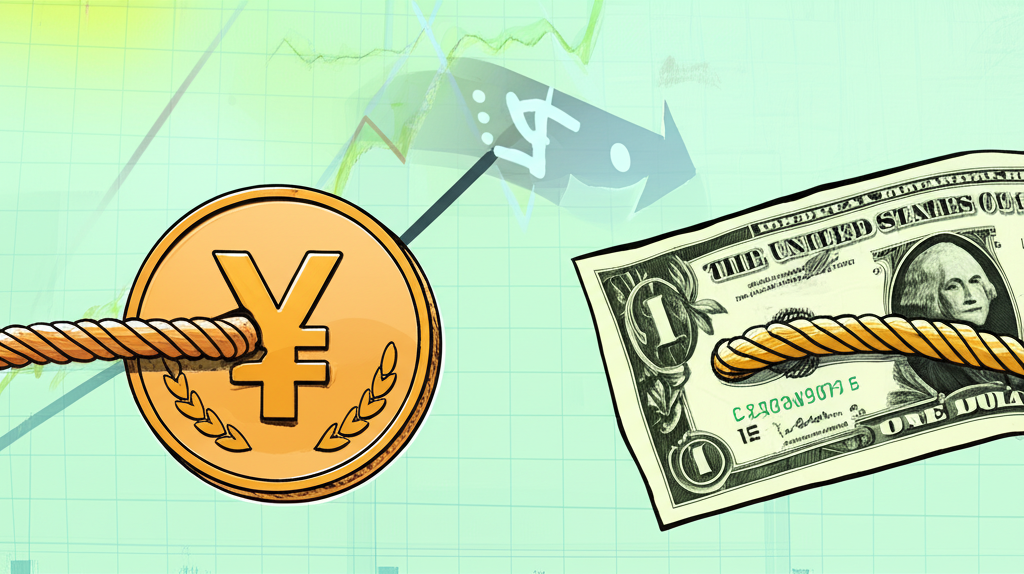
Japanese Yen News Today: 3 Factors Driving JPY Volatility and BoJ’s Next Steps
Table of Contents
ToggleExecutive Summary: Today’s Top Japanese Yen Headlines

The Japanese Yen remains under intense scrutiny as it navigates a fragile balance between domestic policy constraints and global financial currents. With the Bank of Japan maintaining an unusually accommodative stance compared to its global peers, the currency continues to face downward pressure, particularly against the US Dollar. Market participants are closely monitoring inflation trends within Japan, the central bank’s evolving rhetoric, and shifting global risk dynamics. Despite a gradual rise in domestic price pressures, the BoJ has moved cautiously, leaving interest rates near zero even after officially exiting negative territory in early 2024. This persistent divergence in monetary policy—especially with the Federal Reserve holding firm on higher rates—is fueling carry trades that weigh on the Yen. At the same time, geopolitical tensions and fluctuations in global equity markets occasionally revive the JPY’s traditional safe-haven appeal, creating a volatile and unpredictable environment for traders and investors alike.
Current Japanese Yen Market Overview

Over the past 24 hours, the Japanese Yen has shown mixed signals, reflecting the ongoing battle between Japan’s sluggish policy normalization and stronger external economic forces. The USD/JPY pair has oscillated within a tight range, reacting sharply to US economic releases and shifts in Treasury yields. While the dollar benefits from elevated US interest rates, any hint of a dovish pivot from the Fed tends to trigger temporary rebounds in the Yen. Market volatility has remained moderate, though pockets of heightened activity emerge around data releases and central bank speeches. Traders are increasingly focused on whether the Bank of Japan will deliver further rate hikes in the coming months, or if it will continue to lag behind global tightening cycles. The lack of decisive policy action keeps the Yen vulnerable, but recurring risk-off episodes—such as equity selloffs or geopolitical flare-ups—continue to offer intermittent support.
USD/JPY: What’s Moving the Pair Today?

The movement in the USD/JPY exchange rate today hinges largely on the stark contrast in monetary policy trajectories between the United States and Japan. With the Federal Reserve maintaining a restrictive stance to anchor inflation, US Treasury yields remain elevated, making dollar-denominated assets more attractive. This dynamic strengthens the carry trade, where investors borrow low-yielding yen to invest in higher-yielding dollar assets, thereby pushing USD/JPY upward. However, this trend isn’t immune to change. Weaker-than-expected US economic data—such as a softer jobs report or cooling inflation—could prompt speculation of earlier rate cuts, narrowing the yield gap and offering temporary relief to the Yen. On the Japanese side, any indication that the BoJ is preparing for another rate hike or a shift in its yield curve control framework could spark a sharp reversal. Recent US inflation data, including the Consumer Price Index (CPI) report from the U.S. Bureau of Labor Statistics, has repeatedly triggered volatility in the pair, underscoring how sensitive USD/JPY remains to external data surprises.
The Bank of Japan’s Influence: Monetary Policy Updates

The Bank of Japan remains the single most influential force shaping the Yen’s value, yet its approach continues to diverge from global norms. While most major central banks have aggressively hiked rates to combat inflation, the BoJ has maintained an ultra-loose monetary framework, including yield curve control and minimal interest rates. Although it formally ended its negative interest rate policy in March 2024, the subsequent rate adjustment was marginal—lifting rates from -0.1% to just 0.1%—leaving real rates effectively unchanged in practical terms. Governor Kazuo Ueda and his board have consistently emphasized the need for caution, citing the fragile nature of inflation’s resurgence and the risk of derailing Japan’s fragile growth momentum. As a result, long-term Japanese government bond yields remain suppressed, reinforcing the attractiveness of the dollar carry trade. Markets are now parsing every public statement for clues about future tightening, particularly whether the BoJ will adjust its bond purchase program or signal readiness for a second rate hike later in 2024. Until then, the policy gap with the US and Europe will likely keep the Yen under pressure.
Inflation and Economic Data: Key Drivers for the Yen
Japanese economic indicators are increasingly in the spotlight as investors assess the likelihood of sustained monetary tightening. Recent CPI figures show inflation inching closer to the BoJ’s 2% target, driven by rising service prices and wage growth linked to stronger labor negotiations. However, core inflation—excluding volatile fresh food—remains below levels that would justify aggressive rate hikes. The latest GDP data revealed modest expansion, supported by tourism and domestic consumption, but manufacturing and export sectors continue to face headwinds from global demand softness. Trade balance reports highlight Japan’s vulnerability as a net energy importer; persistent deficits due to high oil prices have weighed on the current account and indirectly pressured the Yen. Industrial production data has been uneven, reflecting supply chain adjustments and weaker demand from China. These indicators collectively shape market expectations: stronger, broad-based inflation and solid growth could push the BoJ toward faster normalization, boosting the Yen. Conversely, any signs of stagnation reinforce the case for prolonged easing. Traders regularly consult releases from the Bank of Japan’s Statistics Department to gauge the central bank’s next move.
Geopolitical and Global Economic Factors Affecting JPY
Beyond domestic monetary policy, the Japanese Yen’s performance is deeply intertwined with global risk dynamics. Historically regarded as a safe-haven currency, the JPY tends to appreciate during periods of financial stress, geopolitical instability, or sharp equity market corrections. For instance, escalations in Middle East conflicts, trade tensions, or banking sector disruptions often trigger capital inflows into yen-denominated assets. This flight-to-safety behavior is amplified by Japan’s status as the world’s largest net creditor nation, meaning it owns more foreign assets than it owes, enhancing confidence in the currency’s stability. On the flip side, during periods of strong global growth and risk-on sentiment, investors favor higher-yielding currencies, leading to JPY depreciation. Energy prices also play a critical role—since Japan imports nearly all its oil and gas, rising commodity costs widen the trade deficit and weaken the Yen. The current environment, marked by uneven global growth, persistent inflation in major economies, and ongoing geopolitical risks, creates a tug-of-war for the Yen’s valuation, with its safe-haven appeal often offset by yield disadvantages.
Expert Forecasts and Analyst Outlook for the Japanese Yen
Market expectations for the Japanese Yen vary widely, reflecting the uncertainty surrounding both domestic policy shifts and global macro trends. Analysts generally agree that the near-term path of USD/JPY will depend on the interplay between Fed policy direction and BoJ hawkishness. If the Federal Reserve begins cutting rates in late 2024 while the BoJ delivers additional hikes, the Yen could see meaningful appreciation. However, if US inflation proves stickier and the Fed holds rates higher for longer, the yen may remain under pressure despite modest tightening in Japan.
**Table 1: Analyst USD/JPY Forecast Ranges (Short-to-Medium Term)**
| Institution | Q3 2024 Forecast Range | Q4 2024 Forecast Range | Key Rationale |
| :———- | :——————— | :——————— | :———— |
| Institution A | 152.00 – 158.00 | 148.00 – 155.00 | BoJ caution, Fed policy. |
| Institution B | 150.00 – 156.00 | 145.00 – 152.00 | Gradual BoJ shifts, global risk. |
| Institution C | 153.00 – 159.00 | 149.00 – 156.00 | Persistent rate differentials. |
Many strategists see 155–160 as a potential trigger zone for intervention by Japanese authorities, given past precedents. Conversely, a move toward 145 could signal a shift in market confidence in BoJ normalization. Scenarios involving sharp risk-off events—such as a global recession or financial crisis—could drive USD/JPY well below 140, underscoring the Yen’s dual role as both a low-yield funding currency and a crisis hedge.
Long-Term Yen Outlook: Beyond Today’s News
Looking ahead to 2025 and beyond, the Japanese Yen’s trajectory will depend on structural economic reforms as much as monetary policy. Japan’s aging population and shrinking labor force continue to constrain long-term growth potential, posing challenges for productivity and fiscal sustainability. These demographic pressures could weigh on investor confidence and limit the Yen’s appeal as a long-term investment currency. However, there are countervailing forces. The BoJ’s gradual shift toward policy normalization—if sustained—could restore credibility and attract capital inflows. Moreover, Japan’s massive net foreign asset position—over $3 trillion—provides a structural floor for the Yen, as repatriation flows during crises can support demand. The corporate sector’s increasing focus on shareholder returns and digital transformation may also improve Japan’s economic resilience. Ultimately, the Yen’s long-term strength will hinge on whether policymakers can foster sustainable growth, achieve inflation stability, and adapt to a rapidly changing global economic order.
Understanding Yen Volatility: Historical Context and Interventions
The Japanese Yen has a long history of sharp, intervention-driven moves, particularly during episodes of excessive depreciation. In 2022, as USD/JPY surged past 150, the Ministry of Finance, in coordination with the Bank of Japan, launched multiple large-scale interventions, reportedly spending over ¥9 trillion to stem the Yen’s slide. These actions, while not always publicly confirmed at the time, were evident from sudden reversals in exchange rate trends and official reserve data. The effectiveness of such interventions is often debated—while they can slow momentum and signal resolve, they rarely reverse trends without supportive monetary or fiscal adjustments. Market participants remain alert to signs of fresh intervention, especially as USD/JPY approaches previous thresholds. Historical precedents suggest that coordinated messaging from the government, paired with intervention, tends to have a more lasting impact. For detailed coverage of past operations, Reuters reports on currency interventions offer valuable insights into the tactics and timing used by Japanese authorities.
Actionable Insights for Investors and Traders
For those navigating the complexities of Yen trading, a multi-faceted approach is essential. Monitoring the BoJ’s policy signals—particularly forward guidance and inflation assessments—is critical, as even subtle shifts can trigger outsized market reactions. Equally important are US economic indicators, especially CPI, employment data, and Federal Open Market Committee (FOMC) statements, which influence yield differentials. From a technical standpoint, USD/JPY levels such as 155 and 160 are widely watched as potential intervention zones, while breaks below 150 could invite short-term buying interest. Conversely, sustained moves above 155 may attract profit-taking. Traders should also consider broader risk sentiment: during equity market selloffs or geopolitical crises, the Yen often outperforms due to its safe-haven status. Given the currency’s sensitivity to sudden policy shifts and external shocks, robust risk management—through position sizing, stop-loss orders, and portfolio diversification—is crucial for long-term success.
Frequently Asked Questions (FAQ)
What is the current exchange rate for the Japanese Yen today?
The current exchange rate for the Japanese Yen against major currencies like the US Dollar (USD/JPY) fluctuates throughout the day based on market conditions. For real-time rates, it’s best to consult a reputable financial news site or currency exchange platform.
Why has the Japanese Yen been experiencing recent volatility?
Recent JPY volatility stems primarily from the significant interest rate differential between Japan and other major economies, particularly the U.S. Speculation about the Bank of Japan’s future monetary policy, global risk sentiment, and key economic data releases also contribute to its fluctuations.
How do interest rate differentials between Japan and the US impact the Yen?
When US interest rates are significantly higher than Japan’s, investors tend to sell JPY and buy USD to take advantage of higher returns (known as “carry trade”), leading to JPY weakness. Conversely, a narrowing of this differential could strengthen the Yen.
What are analysts predicting for the Japanese Yen against the Euro?
Analysts’ predictions for EUR/JPY are influenced by similar factors as USD/JPY, but also by the European Central Bank’s (ECB) policy. If the ECB tightens more aggressively than the BoJ, EUR/JPY might rise. If the BoJ surprises with hawkish moves, the Yen could strengthen against the Euro. Forecasts vary widely.
Has the Bank of Japan intervened in the currency market recently?
While the BoJ officially ended negative interest rates in March 2024, direct currency interventions by the Ministry of Finance (acting through the BoJ) are typically not announced in advance. Markets watch for official reports and sudden, large movements in the exchange rate that suggest intervention, as seen in 2022.
What economic reports should I watch that influence the Yen?
Key reports include Japan’s CPI (inflation), GDP growth, trade balance, and industrial production. From the US, watch CPI, employment data (Non-Farm Payrolls), and FOMC statements. Global economic growth figures and geopolitical news are also important.
How does Japan’s trade balance affect the value of its currency?
A trade surplus (exports exceeding imports) generally indicates higher demand for the Yen from foreign buyers, strengthening the currency. A trade deficit (imports exceeding exports), especially if driven by high energy prices, can put downward pressure on the Yen.
What is the Japanese Yen’s forecast for 2025?
The 2025 forecast for the Japanese Yen is complex and depends heavily on the future trajectory of global interest rates, the Bank of Japan’s monetary policy normalization, and the health of the global economy. Many analysts expect a gradual appreciation of the Yen if the BoJ continues to normalize policy and if global central banks begin to cut rates.
Is now a good time to buy or sell USD/JPY?
This question cannot be answered as financial advice. Investment decisions depend on individual financial goals, risk tolerance, and market analysis. It is crucial to conduct your own research or consult with a qualified financial advisor before making any trading decisions.
Where can I find live Japanese Yen news updates?
You can find live Japanese Yen news updates from major financial news outlets such as Reuters, Bloomberg, The Wall Street Journal, and reputable currency trading platforms. These sources often provide real-time data, expert analysis, and breaking news.
You may also like
Calendar
| 一 | 二 | 三 | 四 | 五 | 六 | 日 |
|---|---|---|---|---|---|---|
| 1 | 2 | 3 | 4 | 5 | 6 | 7 |
| 8 | 9 | 10 | 11 | 12 | 13 | 14 |
| 15 | 16 | 17 | 18 | 19 | 20 | 21 |
| 22 | 23 | 24 | 25 | 26 | 27 | 28 |
| 29 | 30 | 31 | ||||
發佈留言
很抱歉,必須登入網站才能發佈留言。